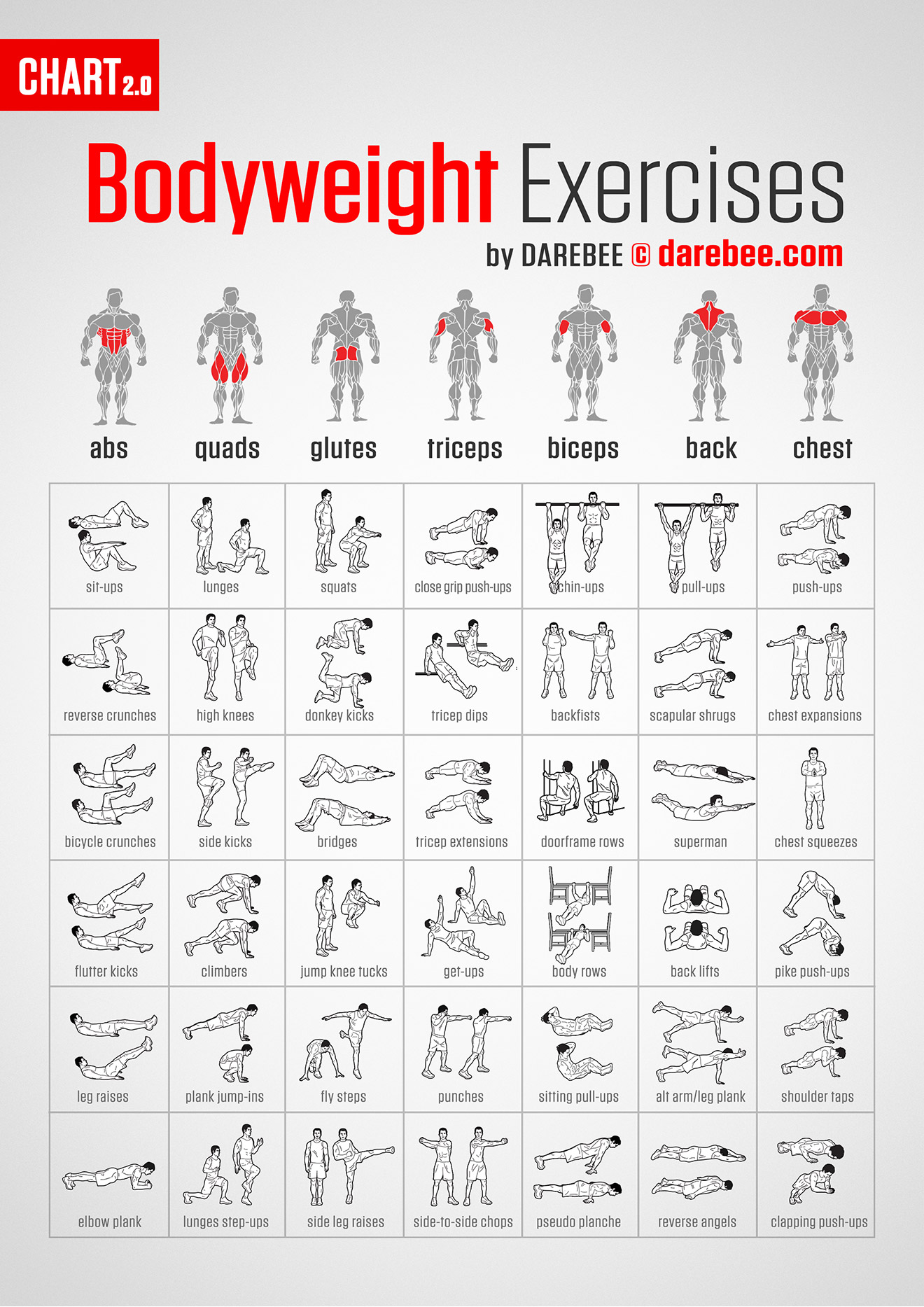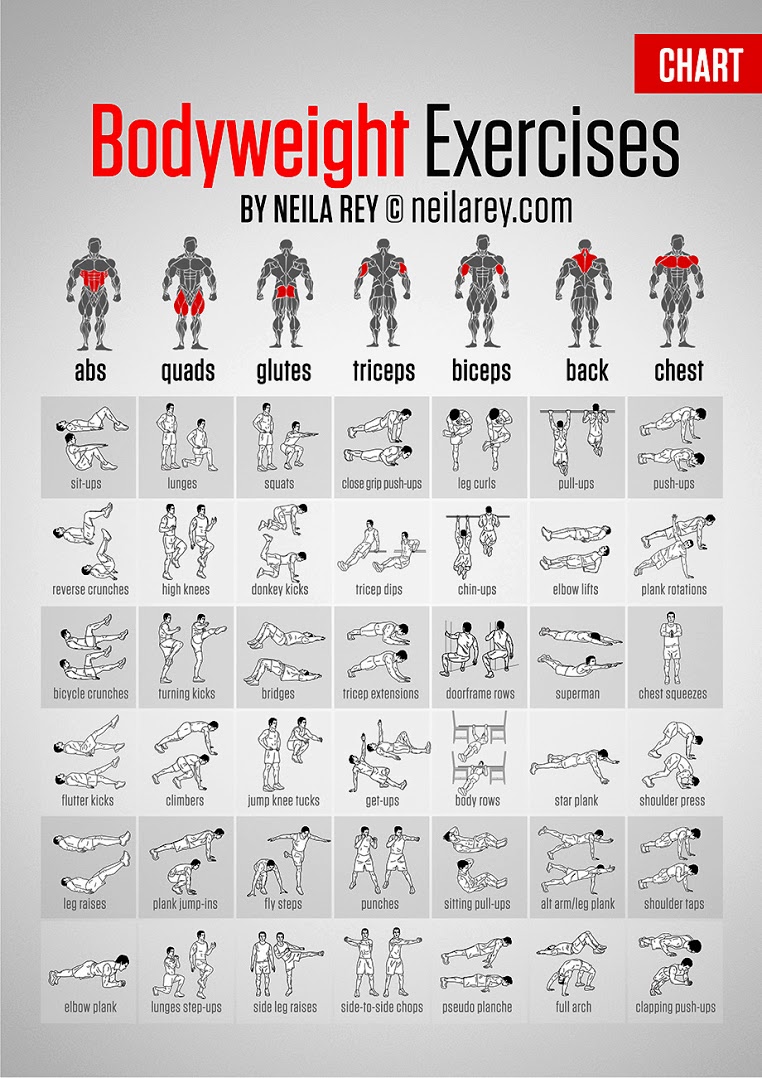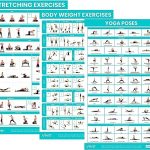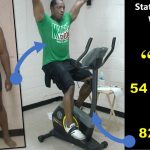Are you tired of searching for the perfect workout routine that fits into your busy schedule? Do you want to get fit without the hassle of expensive gym memberships or bulky equipment?
You’re in the right place. Bodyweight workout exercises are your ticket to achieving a toned, strong, and healthy body without leaving the comfort of your home. Imagine transforming your living room into your personal fitness studio, where every push-up and squat brings you closer to your fitness goals.
By the end of this article, you’ll discover simple yet powerful exercises that use just your bodyweight to deliver impressive results. Ready to feel the burn and see the transformation? Let’s dive in and uncover the secrets to a fitter you!

Credit: dailyburn.com
Benefits Of Bodyweight Workouts
Bodyweight workouts offer a range of benefits that make them an attractive option for anyone looking to improve their fitness. From boosting strength to enhancing flexibility, these exercises can be done anywhere, anytime, without the need for expensive equipment. As you dive into the world of bodyweight training, you’ll find yourself not only building muscle but also gaining confidence and control over your body. Let’s explore the unique advantages of integrating bodyweight workouts into your routine.
1. Accessible To Everyone
No gym membership? No problem. Bodyweight workouts can be performed in your living room, park, or hotel room. All you need is some space and your own body. This accessibility breaks down barriers, making fitness attainable for everyone.
2. Cost-effective
Forget about spending money on expensive equipment. The beauty of bodyweight exercises lies in their simplicity. You won’t need weights, machines, or fancy gear. Just your body and perhaps a mat.
3. Improve Functional Strength
Bodyweight workouts mimic natural movements. Think squatting, pushing, and pulling—actions you perform daily. This helps improve your functional strength, making everyday tasks easier and less strenuous.
4. Enhance Flexibility And Balance
Exercises like yoga or Pilates focus on stretching and balance. These movements increase your flexibility and improve your balance, reducing the risk of injuries. How often do you think about balance when working out?
5. Time-efficient
Short on time? Bodyweight workouts can be intense and effective in just minutes. High-intensity interval training (HIIT) routines are a great way to maximize your workout in less time. You’ll be surprised at how much you can achieve in a short span.
6. Adaptable To Your Fitness Level
Whether you’re a beginner or advanced, bodyweight exercises can be tailored to your level. Want a challenge? Try adding more reps or increasing the speed. You’re in control of the intensity.
7. Promote Mental Well-being
Engaging in bodyweight workouts not only benefits your physical health but also boosts your mental well-being. The act of moving and challenging your body releases endorphins, improving your mood and reducing stress.
Are you ready to give bodyweight workouts a try? With so many benefits, they might just be the perfect fit for your lifestyle. Remember, the journey to fitness is personal. Listen to your body, and enjoy the process. What changes will you notice first?
Core Strength Exercises
Strengthening your core is essential for overall fitness and stability. Core exercises improve posture, balance, and can help prevent injuries. A strong core supports daily activities and enhances performance in other workouts. Let’s explore some effective bodyweight exercises for core strength.
Planks
Planks are one of the best exercises for the core. They engage multiple muscles at once. Begin by lying face down. Then, lift your body onto your elbows and toes. Keep your body straight. Hold this position as long as you can. Planks improve endurance and build strength.
Russian Twists
Russian twists target the oblique muscles. Sit on the floor with your knees bent. Lean back slightly. Lift your feet off the ground. Hold your hands together in front of you. Twist your torso to the right, then to the left. Keep twisting side to side. This exercise enhances core rotation strength.
Bicycle Crunches
Bicycle crunches are great for the entire core. Lie on your back with your hands behind your head. Lift your legs off the ground. Bring your right elbow towards your left knee. Then switch sides. This movement mimics pedaling a bicycle. Bicycle crunches boost core stability and coordination.
Upper Body Workouts
Upper body workouts are essential for building strength and endurance in your arms, shoulders, chest, and back. These exercises require no equipment and can be done anywhere, making them a convenient choice for anyone looking to get fit. Whether you’re a beginner or a seasoned fitness enthusiast, bodyweight exercises are a great way to enhance your upper body strength.
Push-ups
Push-ups are a classic exercise that targets the chest, shoulders, and triceps. To do a push-up, start in a plank position with your hands slightly wider than shoulder-width apart. Lower your body until your chest nearly touches the floor, then push back up to the starting position.
Try starting with 5 to 10 push-ups, gradually increasing as you build strength. Can’t do a full push-up yet? No worries, start with knee push-ups or incline push-ups using a bench or wall. Have you ever noticed how a simple exercise like push-ups can transform your upper body strength over time?
Tricep Dips
Tricep dips are excellent for toning the back of your arms. Find a sturdy chair or low table. Sit on the edge, place your hands next to your hips, and slide your buttocks off the seat while keeping your legs straight or bent.
Lower your body until your elbows are at a 90-degree angle, then push yourself back up. Aim for 3 sets of 10 dips to start. If you ever feel your triceps burning, that’s the feeling of progress. Are you ready to challenge yourself to a few extra reps?
Pull-ups
Pull-ups are a powerful exercise for your back, shoulders, and arms. You’ll need a pull-up bar for this exercise. Grip the bar with your palms facing away from you, hands slightly wider than shoulder-width.
Pull your body up until your chin is above the bar, then lower yourself back down with control. It’s normal if you can’t do many at first—try assisted pull-ups or negative pull-ups. Did you know that consistent practice can drastically improve your pull-up count and upper body strength? Why not set a goal for yourself today?
Incorporating these exercises into your routine can significantly enhance your upper body strength and endurance. Remember, consistency is key. How will you start integrating these workouts into your fitness journey?

Credit: www.amazon.com
Lower Body Exercises
Strengthening the lower body boosts balance and endurance. These exercises target key muscles like thighs, calves, and glutes. No equipment needed. You can perform them anywhere, anytime.
Squats
Squats are essential for building leg strength. Stand with feet shoulder-width apart. Lower your hips as if sitting back in a chair. Keep your chest up and knees behind toes. Return to standing. Perform several reps to engage your thighs and glutes.
Lunges
Lunges improve flexibility and strength. Start by standing tall. Step forward with one leg, lowering hips until both knees are bent. Keep your front knee over your ankle. Push back to starting position. Alternate legs to work each side evenly.
Calf Raises
Calf raises enhance calf muscles. Stand with feet hip-width apart. Slowly rise onto your toes, holding the position briefly. Lower back down gently. Repeat this motion for a solid calf workout. It also improves your balance.
Full Body Movements
Full body movements in workouts use multiple muscles at once. These exercises boost strength, endurance, and flexibility. They also burn more calories compared to isolated exercises. Engaging in full body movements is effective and time-saving. Here are some key exercises that provide full body benefits.
Burpees
Burpees are a powerful exercise. Start by standing straight. Drop into a squat position, placing hands on the ground. Jump your feet back into a plank position. Quickly return to a squat. Jump up with hands raised. This sequence works the entire body. It improves cardiovascular fitness and builds strength.
Mountain Climbers
Mountain climbers are dynamic and energizing. Begin in a plank position. Bring one knee toward your chest. Switch legs in a fast, running motion. Keep your core tight and back straight. This exercise strengthens core muscles. It also enhances agility and endurance. Perfect for a quick energy boost.
Jumping Jacks
Jumping jacks are a classic full body exercise. Start by standing with feet together. Jump while spreading your legs and raising arms overhead. Return to the starting position in one motion. This exercise increases heart rate rapidly. It improves coordination and muscle endurance. A simple move with significant benefits.

Credit: darebee.com
Flexibility And Balance
Improve flexibility and balance through bodyweight workout exercises. These workouts enhance coordination and stabilize muscles. Simple movements like lunges, squats, and planks build core strength and promote body awareness. Regular practice helps maintain a healthy posture and prevents injuries.
Flexibility and balance are crucial components of a well-rounded bodyweight workout. They not only enhance your physical performance but also improve your posture and prevent injuries. You might find yourself wondering how often you should focus on these elements. The answer is: as often as possible! By integrating exercises that emphasize flexibility and balance, you’ll experience a noticeable boost in your overall fitness journey.Yoga Poses
Yoga is a fantastic way to improve flexibility and balance. Start with the classic Downward Dog pose. It stretches your hamstrings, calves, and spine. Imagine feeling the tension melt away as you hold the pose. Another effective pose is the Tree Pose. Stand on one leg and bring the opposite foot to your inner thigh. Focus on steadying your breath to maintain balance. Each time you wobble, remember that it’s part of the learning process.Pilates Moves
Pilates is excellent for developing core strength and balance. Try the Plank with Leg Lift. Start in a standard plank position. Lift one leg and hold for a few seconds before switching sides. Feel your core engaging and your stability improving. The Single Leg Stretch is another move to try. Lie on your back and alternate pulling one knee towards your chest while extending the other leg. This move challenges your balance and enhances flexibility in your hip flexors.Tai Chi Forms
Tai Chi offers gentle movements that foster balance. Begin with the Brush Knee form. Step forward, brush one hand across your knee, and extend the other hand forward. It’s a graceful move that teaches control and coordination. The Golden Rooster Stands on One Leg is another intriguing form. Balance on one foot while lifting the opposite knee. This movement not only improves your balance but also boosts mental focus. As you explore these exercises, remember to listen to your body. Each pose, move, and form has its own rhythm. You might ask yourself how these practices can transform your daily routine. Consider the newfound agility and peace of mind they bring. These exercises are not just about physical benefits; they’re pathways to a healthier, more balanced life.Creating A Custom Routine
Crafting a personalized routine with bodyweight exercises enhances fitness goals. These exercises require no equipment and fit any schedule. By focusing on strength and flexibility, a custom plan can improve overall wellness.
Creating a custom bodyweight workout routine can transform your fitness journey. It offers flexibility, allowing you to adapt exercises to fit your needs. You can design workouts to target specific muscles or enhance overall strength. This approach ensures you stay motivated and achieve your fitness goals. Crafting a personalized plan involves understanding your objectives and managing workout intensity. Establishing a routine helps maintain consistency and track progress effectively. Let’s explore how you can tailor your bodyweight exercises to create the perfect routine.Setting Goals
Define what you want to achieve with your workouts. Are you aiming to build strength or improve endurance? Clear goals guide your exercise selection and progression. Write down your objectives to stay focused. Consider both short-term and long-term targets for balanced growth.Balancing Intensity
Find the right level of challenge for your workouts. Intensity affects results and motivation. Too easy, and you won’t progress; too hard, and you risk burnout. Adjust reps and rest periods to match your current fitness level. Gradually increase difficulty to push your limits without overdoing it.Scheduling Workouts
Create a workout schedule that suits your lifestyle. Consistency is key to seeing results. Decide on workout days and times that you can commit to. Balance exercise with rest days to avoid fatigue. Use a calendar or app to track your sessions and stay on track.Adapting For Different Fitness Levels
Bodyweight workout exercises offer flexibility for all fitness levels. Beginners can start with basic movements, while advanced athletes add intensity. Each exercise can be modified, ensuring effective training tailored to individual abilities.
Adapting your bodyweight workout to suit different fitness levels can make all the difference in achieving your goals. Whether you’re new to exercise or a seasoned athlete, modifying exercises ensures you stay challenged without risking injury. Let’s dive into how you can tailor your bodyweight workout to fit your unique fitness level.Beginner Modifications
Starting with the basics is crucial. If you’re new to bodyweight workouts, you may find full push-ups challenging. Try starting with knee push-ups instead. This modification reduces the weight your arms and chest need to lift, making it easier to build strength gradually. Similarly, when doing squats, use a chair for support. It helps maintain balance and encourages proper form. Don’t be afraid to take breaks as needed. Listen to your body and rest when you need to. Consistency is key, so aim for small, steady progress.Advanced Variations
For those who want more of a challenge, there are plenty of ways to intensify your workout. Consider adding a plyometric element to your exercises. Jump squats and clapping push-ups are excellent for building explosive strength. Try incorporating single-leg variations. Single-leg squats or single-arm push-ups increase the demand on your muscles, enhancing balance and coordination. Increase your workout intensity by reducing rest times. This keeps your heart rate up and maximizes calorie burn.Safety Tips
Safety should always come first. Ensure you warm up before every workout to prepare your muscles and prevent injury. A few minutes of light cardio and dynamic stretching will do the trick. Maintain proper form throughout each exercise. Poor form can lead to injuries, which can sideline you from achieving your fitness goals. If you’re unsure about your form, consider recording yourself to check your posture or ask a knowledgeable friend for feedback. Listen to your body. If you feel pain, stop immediately. There’s a difference between the discomfort of a challenging workout and actual pain. Always err on the side of caution. So, how will you adjust your bodyweight workout to suit your fitness level today? Remember, the key is to challenge yourself safely and effectively. Happy exercising!Tracking Progress
Tracking progress is crucial in bodyweight workouts. It keeps you motivated and helps measure improvement. Discovering effective ways to track progress can enhance your fitness journey. Let’s explore how to do it efficiently.
Using Fitness Apps
Fitness apps are great tools for tracking workouts. They offer features to log exercises and monitor progress. Many apps provide reminders and tips. This helps maintain consistency in your fitness routine. Some apps even allow you to share achievements with friends. Choose an app that suits your needs and offers easy navigation.
Recording Measurements
Measurements provide tangible results of your efforts. Record weight, body measurements, and other statistics regularly. Keep a journal or use an app for this purpose. Consistent tracking helps you notice changes over time. It aids in understanding what works best for your body. Use simple methods to measure and record accurately.
Setting Milestones
Milestones create short-term goals that lead to larger achievements. Set realistic milestones in your workout plan. This helps maintain focus and motivation. Achieving small goals boosts confidence and encourages progress. Celebrate each milestone reached. Adjust milestones as you advance in your fitness journey.
Staying Motivated
Staying motivated during bodyweight workouts can be tough. Often, the initial excitement fades. Keeping that spark alive is crucial. Motivation helps you stick to your workout routine. It ensures you achieve your fitness goals. Explore ways to keep your enthusiasm high.
Joining Online Communities
Online communities offer support and motivation. They connect you with like-minded individuals. You can share progress and challenges. These platforms provide valuable tips. They keep your workout routine fresh and exciting. Join a forum or a social media group today.
Finding A Workout Buddy
A workout buddy keeps you accountable. They motivate you to push harder. Having a partner makes workouts more fun. You can challenge each other and celebrate progress. Choose someone with similar fitness goals. Together, you can achieve more.
Rewarding Achievements
Celebrate your milestones, big or small. Rewarding yourself boosts motivation. It reinforces positive behavior. Set achievable goals and treat yourself. This could be a new workout outfit. Or a relaxing spa day. Rewards make the journey enjoyable.
Frequently Asked Questions
What Are Bodyweight Exercises?
Bodyweight exercises use your body’s weight as resistance. They include push-ups, squats, and lunges. These exercises improve strength, flexibility, and balance. They’re convenient and can be performed anywhere without equipment. They’re ideal for all fitness levels, providing an effective workout solution.
Can Beginners Do Bodyweight Workouts?
Yes, beginners can start with bodyweight workouts. These exercises are adaptable and can be modified for any fitness level. Begin with basic movements like squats and push-ups. Gradually increase intensity as you progress. They’re an excellent introduction to strength training, requiring no equipment.
How Often Should I Do Bodyweight Workouts?
Perform bodyweight workouts 3 to 4 times weekly. This frequency balances recovery and progress. Beginners can start with fewer sessions and gradually increase. Ensure to include rest days to prevent overtraining. Listening to your body and adjusting accordingly is key for optimal results.
Are Bodyweight Exercises Effective For Weight Loss?
Yes, bodyweight exercises can aid weight loss. They burn calories while building muscle, boosting metabolism. High-intensity workouts enhance calorie burn post-exercise. Combine with a balanced diet for best results. Consistency is crucial, ensuring gradual and sustainable weight loss.
Conclusion
Bodyweight exercises offer a simple way to stay fit. No equipment needed. Perfect for any fitness level. You can do them anywhere. At home. In a park. Even during travel. These exercises improve strength, flexibility, and endurance. Regular practice boosts overall health.
Keeps your body active and healthy. Consistency is key to seeing results. Mix different exercises for variety. Avoid boredom. Stay motivated and enjoy your workouts. A healthy routine leads to a healthier life. Start today. Feel stronger tomorrow.





